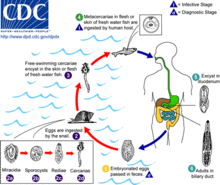| Opisthorchis felineus | |
|---|---|

| |
| Scientific classification | |
| Domain: | Eukaryota |
| Kingdom: | Animalia |
| Phylum: | Platyhelminthes |
| Class: | Trematoda |
| Order: | Plagiorchiida |
| Family: | Opisthorchiidae |
| Genus: | Opisthorchis |
| Species: | O. felineus
|
| Binomial name | |
| Opisthorchis felineus | |
Opisthorchis felineus, the Siberian liver fluke or cat liver fluke, is a trematode parasite that infects the liver in mammals. It was first discovered in 1884 in a cat's liver by Sebastiano Rivolta of Italy. In 1891, Russian parasitologist, Konstantin Nikolaevich Vinogradov (1847–1906)[2] found it in a human, and named the parasite a "Siberian liver fluke". In the 1930s, helminthologist Hans Vogel of Hamburg published an article describing the life cycle of Opisthorchis felineus.[3] Felineus infections may also involve the pancreatic ducts. Diagnosis of Opisthorchis infection is based on microscopic identification of parasite eggs in stool specimens. Safe and effective medication is available to treat Opisthorchis infections. Adequately freezing or cooking fish will kill the parasite.
Distribution[edit]
Distribution of Opisthorchis felineus include: Spain, Italy, Albania, Greece, France, Macedonia, Switzerland, Germany, Poland, Russia, Turkey, and Caucasus.[4]
Life cycle[edit]

The first intermediate hosts of the parasite are freshwater snails:
- Bithynia inflata (synonym: Codiella inflata)[5][4]
- Bithynia troschelii[5]
- Bithynia leachii[5][4]
- Bithynia tentaculata[4]
The second intermediate hosts are freshwater fish: Leuciscus idus, Tinca tinca, Abramis brama, white-eye bream Ballerus sapa, Barbus barbus, common carp Cyprinus carpio, Blicca bjoerkna, Leuciscus idus, Alburnus alburnus, Aspius aspius, and common rudd Scardinius erythropthalmus.[4]
The definitive hosts are fish-eating mammals such as dogs, foxes, cats, rats, pigs, rabbits, seals, lions, wolverines, martens, polecats and humans.[4]
Effect on human health[edit]
It is estimated that 1.5 million people in Russia are infected with the parasite. Inhabitants of Siberia acquire the infection by consuming raw, slightly salted and frozen fish.[citation needed]
Opisthorchiasis, the disease caused by Opisthorchis felineus, ranges in severity from asymptomatic infection to severe illness. Patient outcome is dependent on early detection and treatment.[citation needed]
Human cases of opisthorchiasis may affect the liver, pancreas, and gall bladder. If not treated in the early stages, opisthorchiasis may cause cirrhosis of the liver and increased risk of liver cancer, but may be asymptomatic in children.[citation needed]
Two weeks after flukes enter the body, the parasites infect the biliary tract. Symptoms of infection include fever, general felling of tiredness, skin rash, and gastrointestinal disturbances. Severe anemia and liver damage may also incapacitate the infected person for 1–2 months. Treatment of opisthorchiasis is generally with a single dose of praziquantel.[citation needed]
See also[edit]
References[edit]
- ^ Blanchard, R. (1895). Séance du 26 Novembre 1895. Bulletin de la Société zoologique de France 20: 217. Text on biodiversitylibrary.org.
- ^ Ageev, A. K. (1972). "Konstantin Nikolaevich Vinogradov (on the 125th anniversary of his birth)". Arkhiv Patologii. 34 (10): 85–9. PMID 4573523.
- ^ [1] Bernhard Nocht Institute for Tropical Medicine
- ^ a b c d e f Chai, Jong-Yil; Darwin Murrell, K.; Lymbery, Alan J. (2005). "Fish-borne parasitic zoonoses: Status and issues". International Journal for Parasitology. 35 (11–12): 1233–54. doi:10.1016/j.ijpara.2005.07.013. PMID 16143336.
- ^ a b c World Health Organization (1995). Control of Foodborne Trematode Infection. WHO Technical Report Series. 849. PDF part 1, PDF part 2. page 125-126.
External links[edit]
- Armignacco, Orlando; Caterini, Luciano; Marucci, Gianluca; Ferri, Fabrizio; Bernardini, Giuliana; Raponi, Giampaolo Natalini; Ludovisi, Alessandra; Bossù, Teresa; Morales, Maria A. Gomez; Pozio, Edoardo (2008). "Human Illnesses Caused by Opisthorchis felineus Flukes, Italy". Emerging Infectious Diseases. 14 (12): 1902–5. doi:10.3201/eid1412.080782. PMC 2634636. PMID 19046516.